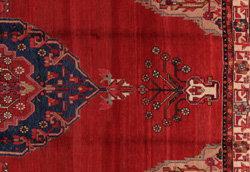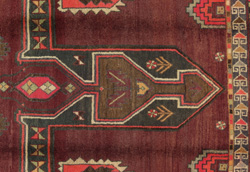Main Category
Origin
|
Size/Shape
|
Sarouk - Farahan Persian Rug 5'3"x3'5"
The colours of each carpet look different depending on the side from which you look at it. You can see the carpet from different perspectives in the images below:
(click on the images below for greater detail)
- Discount Price: £ 150 -30%
- Retail Price: £214
- Rug Code: unq2389-605
- Size: 5'3"x3'5"
- Thickness: Medium (5-10 mm)
- Age: 0-20 (New)
- Pile - Warp: Wool on Cotton
- Knot Density: approximately 120.000 knots per m²
- Rug colors:
Sarouk Rugs : Sarouk is the name of rugs with a rich history, which are woven in the homonymous town as well as in the city of Arak and surrounding areas. Names of rugs from the Sarouk area are also: Feraghan, Feraghan Sarouk, Mahal, Mohajaran Sarouk, Mushkabad and Viss / Golpayegan. The first successes of Sarouk rugs and rugs were largely due to the U.S. market. The Sarouk still continue to be popular among Persian rugs and are made of very good quality wool. The designs are usually floral in style, in ivory beige and in shades of red and blue.
Farahan Rugs : The area Farahan is located in Central Iran, about 580 km south of Tehran between the cities Arak, Qum and Kashan. Nowadays, in Western countries Farahan rugs are also known as Mahal. These rugs have solid construction and fine designs. To create them mineral colours are used that give a copper-rust green colour. They often have got a blue background in the pile, with repeating Herati designs and a medallion that is surrounded by roses and other flowers with delicate lines in a variety of colours. Their wool is soft and of very good quality, which allows for a very fine and tight weave.
Nomadic rugs with designs influenced by urban rugs: They are rugs woven by nomads who for the past few years had been living in villages. The rugs are woven in the nomadic style of weaving, but their designs are nowadays influenced by urban rugs. Due to the nomadic style of weaving rugs are sometimes uneven in shape.
All CarpetU2 carpets are subject to cleaning with high quality antibacterial and moth protection products according to Persian law.
Horizontal or vertical shading in the rug pile: The shading is due to folding the rug during transportation. When the rug is laid and stepped-on they will vanish. Examples
Abrash: Due to the different amount of grease in the wool and the added salt during the process of dyeing, the wool has got a varying colour absorbance. This is not very visible before weaving. During the weaving though, lines of the same colour are formed in the rug. This is called Abrash (which in Farsi means little cloud) and it shows that the wool was not manufactured using chemical means and marks the naturalness and authenticity of the rugs. Examples
You have to choose at least two (2) rugs!
You can select up to six (6) rugs to compare!

 Click here for larger image
Click here for larger image



















